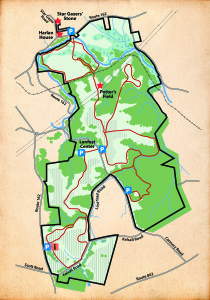Residents can now easily visit the Star Gazer’s Stone

The Star Gazers’ Stone is an historical monument located off Route 162.
Photo Credit: Holly M. Harper, Natural Lands Trust
NEWLIN — The Star Gazers’ Stone is an unassuming quartzite rock measuring no more than 18 inches in height, but it played an outsized role in the political fates of our nation. For many years, the Stone was difficult to access, but—thanks to a new parking area constructed by Natural Lands Trust and Newlin Township—it is now easy to visit and appreciate its significance to early colonial history.
Construction for the new parking area began in June 2012, and the lot has now been open to the public for a few months.
Chair of the Newlin Board of Supervisors Janie Baird said the parking area has provided better access to the attractions.
“By working together Newlin Township and NLT have provided relief from the congestion along a busy road and provided a safer alternative for visitors to both the preserve and Stargazer’s Stone,” Baird said.
Mason and Dixon’s Expedition: In 1763, 240 years before the widespread use of GPS, surveyors and astronomers Charles Mason and Jeremiah Dixon came to the New World to end a bloody, 80-year boundary dispute between Pennsylvania and Maryland. Their survey, which established the official line between the two colonies, stands among the greatest scientific achievements of the time.
While the duo began their expedition in Philadelphia, they quickly realized that they would need to travel along a straight line due south of the capital city, requiring a difficult river crossing. Instead, they selected a location due west of Philadelphia—the forks of the Brandywine Creek in Embreeville, Chester County.
They negotiated with a local farmer to use his property to set up an observatory from which to make their calculations. A reference point, now known as Star Gazers’ Stone, was placed to mark the astronomical meridian line north of their observatory. Using a device with a six-foot-long brass telescope that allowed them to establish their position relative to the stars, they spent the winter nights charting the sky. In the spring of 1764, they ventured due south from the farm with a team of axemen clearing a wide swath through the dense forests. Using chains and levels, they surveyed in straight, 12-mile segments, then made detailed astronomical calculations to adjust to the exact latitude.
All told, the survey took five years—through farm fields and woodlands, frigid winters and oppressive summers, colonial villages and sometimes hostile Native American territories—before Mason and Dixon were satisfied. They’d established the 233-mile-long boundary line between Pennsylvania and Maryland, and the 83-mile-long north-south boundary between Maryland and present-day Delaware.
Star Gazers’ Stone is listed on the National Register of Historic Places and was designated a National Historic Civil Engineering Landmark, one of 125 sites in the country.
ChesLen Preserve: The Stone and a small plot of surrounding land were given to Natural Lands Trust in 2007 by Chester County as part of a 500-acre land transfer that helped establish ChesLen Preserve. The preserve—now encompassing 1,263 acres—is one of the largest privately owned nature preserve in southeastern Pennsylvania. In addition to its ties to Mason and Dixon’s expedition, the preserve’s historical treasures include a circa-1800 potter’s field—a cemetery that is a remnant of the Chester County Poorhouse once located nearby. More recently, the land was part of the 17,000-acre King Ranch to which cattle were shipped from around the country and prepared for sale at market.
Visitor Information: The parking area is located on Route 162 just east of Stargazer Road. A sign located in the parking lot offers a trail map and directions to the nearby Star Gazers’ Stone. You can also download a preserve trail map at natlands.org/preserves-to-visit/list-of-preserves/cheslen-preserve/.






